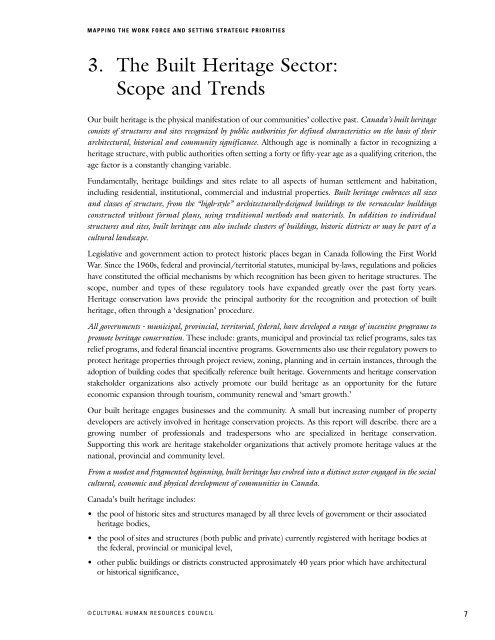Human Resources in Canada's Built Heritage Sector: Mapping the ...
Human Resources in Canada's Built Heritage Sector: Mapping the ...
Human Resources in Canada's Built Heritage Sector: Mapping the ...
- No tags were found...
Create successful ePaper yourself
Turn your PDF publications into a flip-book with our unique Google optimized e-Paper software.
MAPPING THE WORK FORCE AND SETTING STRATEGIC PRIORITIES3. The <strong>Built</strong> <strong>Heritage</strong> <strong>Sector</strong>:Scope and TrendsOur built heritage is <strong>the</strong> physical manifestation of our communities’ collective past. Canada’s built heritageconsists of structures and sites recognized by public authorities for def<strong>in</strong>ed characteristics on <strong>the</strong> basis of <strong>the</strong>irarchitectural, historical and community significance. Although age is nom<strong>in</strong>ally a factor <strong>in</strong> recogniz<strong>in</strong>g aheritage structure, with public authorities often sett<strong>in</strong>g a forty or fifty-year age as a qualify<strong>in</strong>g criterion, <strong>the</strong>age factor is a constantly chang<strong>in</strong>g variable.Fundamentally, heritage build<strong>in</strong>gs and sites relate to all aspects of human settlement and habitation,<strong>in</strong>clud<strong>in</strong>g residential, <strong>in</strong>stitutional, commercial and <strong>in</strong>dustrial properties. <strong>Built</strong> heritage embraces all sizesand classes of structure, from <strong>the</strong> “high-style” architecturally-designed build<strong>in</strong>gs to <strong>the</strong> vernacular build<strong>in</strong>gsconstructed without formal plans, us<strong>in</strong>g traditional methods and materials. In addition to <strong>in</strong>dividualstructures and sites, built heritage can also <strong>in</strong>clude clusters of build<strong>in</strong>gs, historic districts or may be part of acultural landscape.Legislative and government action to protect historic places began <strong>in</strong> Canada follow<strong>in</strong>g <strong>the</strong> First WorldWar. S<strong>in</strong>ce <strong>the</strong> 1960s, federal and prov<strong>in</strong>cial/territorial statutes, municipal by-laws, regulations and policieshave constituted <strong>the</strong> official mechanisms by which recognition has been given to heritage structures. Thescope, number and types of <strong>the</strong>se regulatory tools have expanded greatly over <strong>the</strong> past forty years.<strong>Heritage</strong> conservation laws provide <strong>the</strong> pr<strong>in</strong>cipal authority for <strong>the</strong> recognition and protection of buil<strong>the</strong>ritage, often through a ‘designation’ procedure.All governments - municipal, prov<strong>in</strong>cial, territorial, federal, have developed a range of <strong>in</strong>centive programs topromote heritage conservation. These <strong>in</strong>clude: grants, municipal and prov<strong>in</strong>cial tax relief programs, sales taxrelief programs, and federal f<strong>in</strong>ancial <strong>in</strong>centive programs. Governments also use <strong>the</strong>ir regulatory powers toprotect heritage properties through project review, zon<strong>in</strong>g, plann<strong>in</strong>g and <strong>in</strong> certa<strong>in</strong> <strong>in</strong>stances, through <strong>the</strong>adoption of build<strong>in</strong>g codes that specifically reference built heritage. Governments and heritage conservationstakeholder organizations also actively promote our build heritage as an opportunity for <strong>the</strong> futureeconomic expansion through tourism, community renewal and ‘smart growth.’Our built heritage engages bus<strong>in</strong>esses and <strong>the</strong> community. A small but <strong>in</strong>creas<strong>in</strong>g number of propertydevelopers are actively <strong>in</strong>volved <strong>in</strong> heritage conservation projects. As this report will describe. <strong>the</strong>re are agrow<strong>in</strong>g number of professionals and tradespersons who are specialized <strong>in</strong> heritage conservation.Support<strong>in</strong>g this work are heritage stakeholder organizations that actively promote heritage values at <strong>the</strong>national, prov<strong>in</strong>cial and community level.From a modest and fragmented beg<strong>in</strong>n<strong>in</strong>g, built heritage has evolved <strong>in</strong>to a dist<strong>in</strong>ct sector engaged <strong>in</strong> <strong>the</strong> socialcultural, economic and physical development of communities <strong>in</strong> Canada.Canada’s built heritage <strong>in</strong>cludes:• <strong>the</strong> pool of historic sites and structures managed by all three levels of government or <strong>the</strong>ir associatedheritage bodies,• <strong>the</strong> pool of sites and structures (both public and private) currently registered with heritage bodies at<strong>the</strong> federal, prov<strong>in</strong>cial or municipal level,• o<strong>the</strong>r public build<strong>in</strong>gs or districts constructed approximately 40 years prior which have architecturalor historical significance,©CULTURAL HUMAN RESOURCES COUNCIL7










